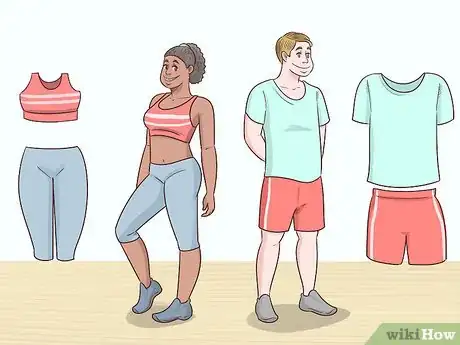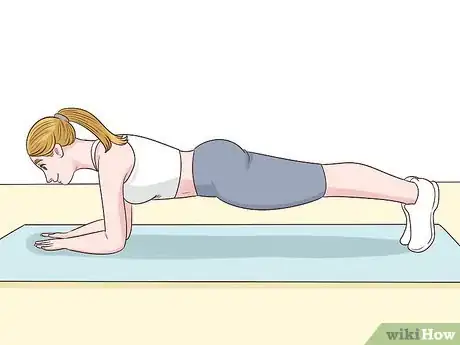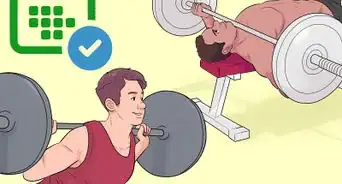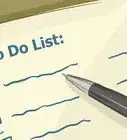This article was co-authored by Brendon Rearick and by wikiHow staff writer, Kyle Hall. Brendon Rearick is a Personal Trainer, Strength Coach, Fitness Program Director, and co-founder of Certified Functional Strength Coach (CSFC), a fitness education company in the San Francisco Bay Area. With 17 years of experience in the fitness industry, Brendon specializes in strength and conditioning, and his company CSFC has certified over 3,000 trainers in over 20 countries. Brendon has worked as a Program Director for Mike Boyle Strength and Conditioning (MBSC) and earned his massage therapy license from the Cortiva Institute-Boston. Brendon holds a BS in Kinesiology from the University of Massachusetts Amherst.
There are 19 references cited in this article, which can be found at the bottom of the page.
This article has been viewed 1,239,597 times.
Going to the gym is a great way to get in shape, but it can be intimidating if you're just starting out. Even if you're a regular at the gym, you might feel like your routine isn't producing results. Fortunately, getting fit in the gym is more than possible, regardless of your personal fitness goals. The key is to develop effective, safe workout habits and to arrive at the gym prepared and ready to succeed.
Steps
Succeeding at the Gym
-
1Come up with a realistic gym schedule that you'll be able to stick to. It may be tempting to plan on going to the gym every day of the week for faster results, but this can lead to burnout and you might feel discouraged if you miss days and don't meet your goal. Instead, decide how many days of the week you can realistically make it to the gym and start there. You can always increase the frequency of your workouts later on when going to the gym becomes more of a habit.[1]
- If you're new to working out, try setting aside 2 days a week to go to the gym. That way, you can get your feet wet without feeling overwhelmed.
- You could also try going to the gym every other day of the week so that you have a day off in between your gym sessions.
- If you think you'd have a hard time going to the gym on the weekends, you could go every day after work or school and then take the weekends off.
-
2Wear comfortable clothes and supportive athletic shoes to the gym. You want to wear clothes that will make your workout easier and that won't get in your way while you're exercising. Go with shirts that will wick away sweat and shorts that don't restrict your range of motion.[2]
- Shirts and shorts made out of polyester, spandex, nylon, or a cotton-polyester blend are good choices for the gym.[3]
- Polyester, in particular, needs to be laundered after every time you sweat in it. Unwashed polyester can quickly develop an unpleasant smell.
Advertisement -
3Bring a water bottle with you to stay hydrated during your workouts. Working out at the gym makes you sweat and lose water, so it's important that you're replenishing your body as you exercise. Aim to drink 8 fluid ounces (240 mL) of water every 15 minutes during your workouts.[4]
- Dehydration can actually negatively affect your workouts by causing cramps and dizziness, as well as making your muscles weaker.
- If you're going to be working out for longer than 1 hour, it's a good idea to bring a sports drink with you too so you can refuel your body. However, not all sports drinks are the same. Look for an isotonic sports drink that contains carbohydrates and sodium, which will give your body more energy during your workout.[5]
-
4Warm up for 5-10 minutes before your workouts so you don't injure yourself. Make it a habit to do your warm-ups right when you get to the gym. Focus on doing active, dynamic movements that bring your muscles through their full range of motion, like leg swings, high knees, and arm circles. A dynamic warm-up will get your body ready for your workout session.[6]
- Not warming up before exercising can leave your body more prone to injury, so make sure you don't skip your warm-ups at the gym.
-
5Do both cardio and strength-training exercises. Try not to limit yourself to just one kind of exercise. Instead, take advantage of the weight machines, cardio machines, and free weights so you're getting a balanced workout. With cardio and strength-training exercises, you'll be burning calories and also toning your muscles and transforming your body.[7]
- Aim to get 150 minutes of moderate cardio a week. For strength training, try to get at least 2 workouts comprised of 20 minutes of resistance training each week.
- You don't need to do cardio and strength training on the same day. Instead, you could spend one workout doing cardio and then your next one doing strength-training.
- While a balanced workout will help you get fit in the gym, you can adjust what exercises you're doing more of depending on your personal fitness goals. For example, if your goal is to build more muscle, you could spend most of your time doing strength-training exercises. Or, if you're trying to lose weight, you could focus more on cardio exercises.
- The right ratio of cardio to strength-training exercises will depend on your personal fitness goals, your weight, and the type of exercises you're doing.
-
6Have a post-workout snack after the gym to replenish your body. Choose a healthy snack with carbs to restore your body's energy, and protein to help build your muscles. If you're trying to lose weight, have a low-calorie snack that's between 150-200 calories.[8]
- For example, you could have a banana and some almond butter or a cup of nonfat Greek yogurt with some honey and fruit as a snack after the gym.[9]
- You could also make a fruit smoothie with some protein powder.
Doing Cardio Exercises at the Gym
-
1Walk or run on a treadmill. Treadmills are available at most gyms, and they're a convenient way to get some cardio exercise in and burn calories. Many treadmills let you adjust the speed and incline that you want to work out with, so it's a good choice regardless of your fitness level.[10]
- You can burn around 125 calories per 1 mile (1.6 km) walking briskly on a treadmill if you weigh 150 pounds (68 kg).[11]
- Using a treadmill can be hard on the knees, so you may want to use a different cardio machine if you suffer from knee pain or have a knee injury.
-
2Try using an elliptical machine. Working out on an elliptical is also a good calorie-burning cardio exercise, and like a treadmill, you can usually adjust your intensity level. Ellipticals are popular exercise machines, so you shouldn't have a hard time finding one at your gym.[12]
- You can burn 170-320 calories in 30 minutes on an elliptical, depending on your weight and the level of intensity you're working out at. For example, if you weigh 200 pounds (91 kg), you could burn 286 calories by working out on an elliptical at a high intensity for 30 minutes.[13]
-
3Exercise on a stationary bike. Pedaling on a stationary bike at moderate intensity for 30 minutes can help you burn 200-700 calories, depending on your weight.[14] It's also a great choice if you have knee problems since most of your body weight is being supported by the machine.[15]
- For example, if you weigh 150 pounds (68 kg), you could burn 250 calories by exercising on a stationary bike with moderate intensity for 30 minutes.
- If you're new to exercising, you can start out pedaling on a light intensity setting and then gradually increase your intensity level as you improve.
-
4Work out on a rowing machine. Rowing is a great, full-body cardio exercise that won't place a lot of stress on your joints. On a rowing machine, you can burn calories while working out your arms, legs, and core. Start out on a low-intensity setting and progress slowly so you don't hurt your back.[16]
- Depending on your weight, you can burn around 400-700 calories by spending 1 hour on a rowing machine. For example, if you weigh 240 pounds (110 kg), you could burn 650 calories by working out on a rowing machine with moderate intensity for 1 hour.
Trying Strength-Training Exercises
-
1Try bodyweight exercises when you're first starting out. Using weight machines and free weights at the gym can be intimidating if you're new to working out. Fortunately, you can still get a good strength-training workout in by doing exercises that only use your bodyweight for resistance.[17] Some bodyweight exercises you can try are:[18]
-
2Do free-weight exercises to add more resistance to your routine. Most gyms will have free weights you can use, like dumbbells and barbells. The extra resistance will make your exercises more effective at building muscle. Start out with light weights that are easy to lift so you can perfect your form, and gradually progress to heavier, more challenging weights. Some free-weight exercises you can try at the gym include:[19]
-
3Give your gym's weight machines a try. Weight machines can be intimidating if you don't know how to use them, but they can be an effective way to build muscle if they're used correctly. If you're interested in using your gym's weight machines but you're not sure how, ask someone who works there to show you the right technique, or consider working with a personal trainer who can show you what to do. Some common weight machines you can try are:[20]
- Lat pulldown machine: A good machine to try if you're looking for an upper body workout, including your latissimus dorsi, biceps, and forearms.
- The Smith machine: It's great for working out your quads, hamstrings, glutes, shoulders, core, and upper back.
- Cable machine: You can use different types of cable machines to add resistance to exercises like shoulder presses, step ups, lateral raises, and crunches.
- Lower back extension machine: It's helpful for exercising the muscles along your back.
Cardio and Strength Training Exercises
Expert Q&A
Did you know you can get premium answers for this article?
Unlock premium answers by supporting wikiHow
-
QuestionWhat should a beginner do at the gym?
 Brendon RearickBrendon Rearick is a Personal Trainer, Strength Coach, Fitness Program Director, and co-founder of Certified Functional Strength Coach (CSFC), a fitness education company in the San Francisco Bay Area. With 17 years of experience in the fitness industry, Brendon specializes in strength and conditioning, and his company CSFC has certified over 3,000 trainers in over 20 countries. Brendon has worked as a Program Director for Mike Boyle Strength and Conditioning (MBSC) and earned his massage therapy license from the Cortiva Institute-Boston. Brendon holds a BS in Kinesiology from the University of Massachusetts Amherst.
Brendon RearickBrendon Rearick is a Personal Trainer, Strength Coach, Fitness Program Director, and co-founder of Certified Functional Strength Coach (CSFC), a fitness education company in the San Francisco Bay Area. With 17 years of experience in the fitness industry, Brendon specializes in strength and conditioning, and his company CSFC has certified over 3,000 trainers in over 20 countries. Brendon has worked as a Program Director for Mike Boyle Strength and Conditioning (MBSC) and earned his massage therapy license from the Cortiva Institute-Boston. Brendon holds a BS in Kinesiology from the University of Massachusetts Amherst.
Personal Trainer & Strength Coach
-
QuestionI want to build my chest. How can I do that?
 Michele DolanMichele Dolan is a BCRPA certified Personal Trainer in British Columbia. She has been a personal trainer and fitness instructor since 2002.
Michele DolanMichele Dolan is a BCRPA certified Personal Trainer in British Columbia. She has been a personal trainer and fitness instructor since 2002.
Certified Fitness Trainer
-
QuestionWhat can I consume to hit my protein requirement after my workout if I have no protein supplements?
 Michele DolanMichele Dolan is a BCRPA certified Personal Trainer in British Columbia. She has been a personal trainer and fitness instructor since 2002.
Michele DolanMichele Dolan is a BCRPA certified Personal Trainer in British Columbia. She has been a personal trainer and fitness instructor since 2002.
Certified Fitness Trainer
References
- ↑ https://www.self.com/story/steps-to-take-start-working-out-for-first-time
- ↑ http://www.businessinsider.com/why-gym-style-matters-2016-3
- ↑ https://www.shape.com/fitness/clothes/10-fitness-fabrics-explained
- ↑ https://www.webmd.com/fitness-exercise/features/water-for-exercise-fitness#1
- ↑ https://www.theguardian.com/lifeandstyle/2009/jul/27/sports-drinks
- ↑ https://www.gq.com/story/warm-up-properly
- ↑ https://www.webmd.com/fitness-exercise/features/10-workout-secrets-expert-exercise-tips#1
- ↑ https://www.self.com/story/10-strength-training-tips-for-beginners-that-will-make-your-workout-more-effective
- ↑ https://www.self.com/story/4-low-calorie-snacks-to-eat-after-you-work-out
- ↑ https://www.webmd.com/fitness-exercise/features/all-bout-exercise-machines#1
- ↑ https://42.195km.net/e/treadsim/
- ↑ https://www.webmd.com/fitness-exercise/features/all-bout-exercise-machines#2
- ↑ https://caloriesburnedhq.com/calories-burned-on-elliptical/
- ↑ http://www.fitnessforweightloss.com/how-many-calories-do-i-burn-on-the-stationary-bike/
- ↑ https://www.webmd.com/fitness-exercise/features/cardio-workouts-to-try#3
- ↑ https://www.webmd.com/fitness-exercise/features/all-bout-exercise-machines#3
- ↑ Brendon Rearick. Personal Trainer & Strength Coach. Expert Interview. 30 July 2020.
- ↑ https://www.self.com/story/10-strength-training-tips-for-beginners-that-will-make-your-workout-more-effective
- ↑ http://www.womenshealthmag.co.uk/fitness/find-a-workout/6391/best-strength-training-free-weights-exercises-for-women-caroline-flack/
- ↑ https://www.webmd.com/fitness-exercise/features/best-exercise-equipment-you-are-not-using#4
About This Article
To get fit at the gym, set yourself a realistic schedule to begin, like going 2 days a week, so you can get used to it without feeling overwhelmed. You should also wear shirts and shorts made out of comfortable materials, like nylon or polyester, which can absorb sweat and won’t restrict your movement. During your workouts, aim to drink 8 ounces of water every 15 minutes, since you need to replenish the fluids in your body and prevent your muscles becoming weaker. In order to burn calories while also toning your muscles, balance your workouts between cardio and strength training exercises, like running on a treadmill and doing push-ups. Afterwards, eat a healthy snack, like a banana, to replenish your body’s nutrients. For tips from our Fitness co-author, including which exercises to do in your cardio and weight training routines, keep reading!










































































